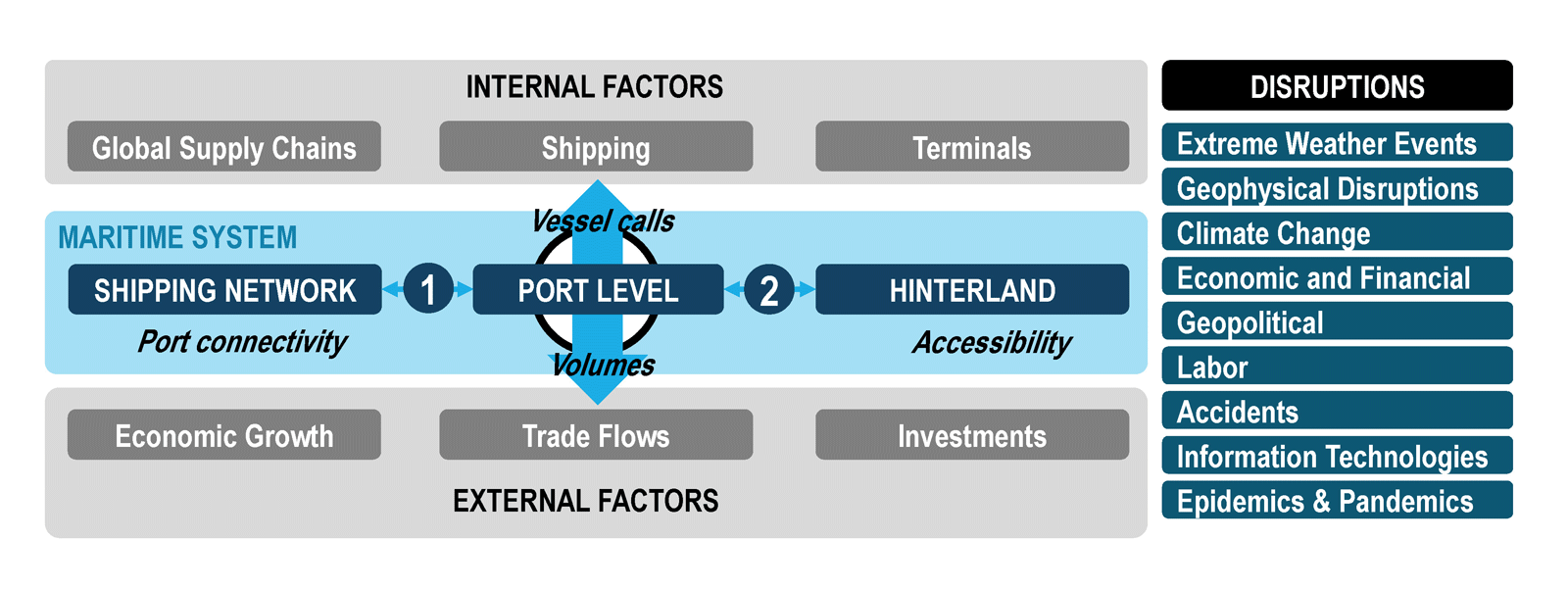Ports are part of a continuum that includes the shipping network and their hinterland and for which they act as an interface (figure 1). Occasionally, a disruptive event (or multiple events) will occur along this landscape, which could have various causes, some predictable, some random but expected, and some unexpected. The resilience of ports and the maritime supply chains they support comprises both internal and external factors.
Figure 1: Ports in the maritime supply chain resilience landscape

External factors relate to the forces that generally affect the demand for maritime transport and therefore impact the volumes handled by shipping and port services. In general, ports and maritime shipping have little or no control over these factors, including economic growth affecting trade flows. Furthermore, agencies outside the shipping industry usually provide investments in equipment and infrastructure. Securing such funding could be contingent upon the type of risk created by the disruption(s). Some external factors can, however, be influenced, including by facilitating investment and funding. Therefore, these factors are to some extent considered as “internal”. For external factors that are more difficult to influence, it is generally recommended to establish monitoring mechanisms and scenario analysis to inform planning and preparedness action.
Disruptions can result from both internal and external factors, depending on the nature of the event. Several disruptions are specifically under the control of infrastructure managers and operators. Examples include breakage of equipment due to improper maintenance, a breach in security, or a lack of cybersecurity measures. These disruptions are within the realm of possible intervention by an actor within the shipping and port industry, and are subject to ownership structure, and regulatory oversight in the various modes of transport, equipment and infrastructure.
Several natural and anthropogenic disruptions fall outside shipping and port control. These include events, such as hurricanes, geopolitical crises, or economic recessions. Even if these elements are outside the realm of port interventions, they are drivers of change to which the port industry must adapt. The internal capability of ports to adapt to external forces is a fundamental element of their resilience.
Two port interfaces highlight the potential points of failure which could occur along a maritime transport chain:
- Ship/port interface: This relates to the interactions between ports, terminal operators and ships/shipping carriers. The actions and strategies of shipping lines can support or undermine port resilience. For instance, the decision of a shipping line to select a port or terminal as a transshipment hub affects a port's resilience in a regional shipping network. A transshipment hub can have improved connectivity to global maritime shipping, but feeder ports may experience a decline of connectivity. Another example is the digitalization decision by shipping lines and ports to improve their interface, particularly by setting up a port community system (PCS). This information platform supports the resilience of the ship/port interface through an enhanced exchange of information between key port users, such as shipping lines, terminal operators, beneficiary cargo owners (BCOs) and carriers.
- Port/hinterland interface: Relates to the interactions between ports, terminal operations and inland transport carriers. This includes infrastructure managers, logistics service providers, and the crucial relations with roads, rail, waterways, transport carriers, and their relations with dry ports, inland container depots, and port-related logistics facilities. The actions and strategies of hinterland actors can support or undermine port resilience. For instance, an improved inland transport infrastructure will increase hinterland connectivity of a port and, by extension, its resilience by ensuring that cargo continues to flow from/to the hinterland to/from the global market.
In some cases, and when not implemented properly, actions by stakeholders may have the unintended effect of causing or amplifying a port disruption and creating additional points of failure. These may not be directly and physically associated with the port interface and include: (i) shippers and cargo owners (providing the cargo); (ii) government agencies (overseeing regulatory aspects, customs, safety, security, and the environment); and (iii) the insurance, finance and banking sectors. For example, cargo owners could become a point of failure when they perform a major change in their procurement strategy, face labour shortages, or even bankruptcy. They may not be able to arrange for the removal of containers in a timely fashion resulting in terminal congestion. They may also delay the return of empty containers and constrain their ability to be used by exporters. Thus, shippers can also influence port resilience.
